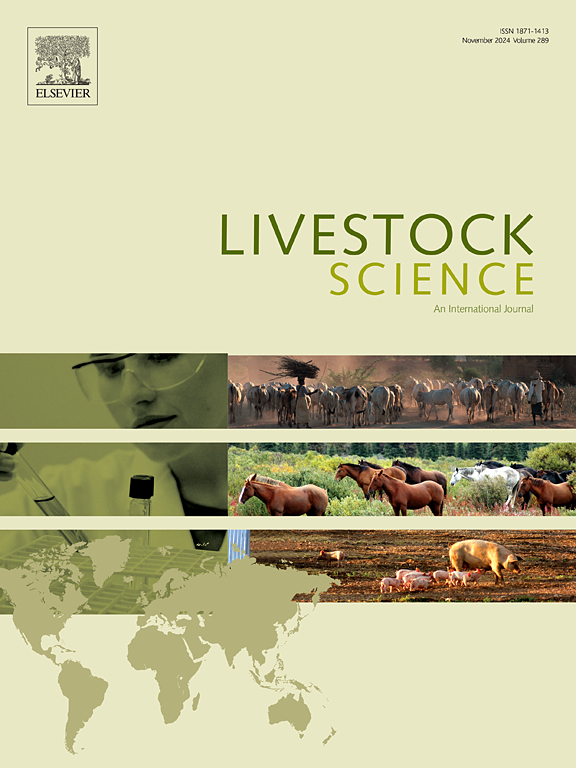Nursing frequency, duration and teat location affect immunoglobulin concentrations in piglets
IF 1.9
3区 农林科学
Q2 AGRICULTURE, DAIRY & ANIMAL SCIENCE
引用次数: 0
Abstract
Two experiments were conducted. The objective of the first experiment was to determine whether the anatomical location of teats affected colostrum quality. Colostrum composition from the first two, middle three, and last three pairs of teats from 18 sows was determined 1 to 2 h before and 24 h after the birth of the first piglet. Protein, IgG and IgA were significantly reduced (P ≤ 0.05), while lactose and fat tended to be reduced (0.05 ≤ P ≤ 0.1) in posterior teats. Immunoglobulin concentrations decreased (P ≤ 0.05) significantly over time regardless of anatomical location. The objective of the second experiment was to determine how much of the variation in piglet immunoglobulin levels was associated with suckling behaviors when considered in conjunction with sow and piglet birth characteristics. Piglet birth variables and suckling behaviors were recorded for 587 piglets from 43 litters beginning with the birth of the first piglet until 4 h after the sow expelled her placenta. Piglet immunocrits were measured 30 ± 3 h after the onset of farrowing. Ten variables from the multiple regression analysis were identified as sources of variation (P ≤ 0.15) for piglet immunocrits (model R2 = 0.6486) with pigs born alive in the current litter (partial R2 = 0.1596; P = 0.0008) and the anatomical location of the pair of teats suckled most (partial R2=0.1410; P = 0.0001) being the most important. Piglets that suckled the last three pairs of teats had reduced immunocrits (P = 0.01; 0.073 ± 0.003) compared with those that suckled the anterior (0.081 ± 0.002) and middle (0.083 ± 0.003) pairs. Piglets from litters with >16 liveborn had reduced (P ≤ 0.05) immunocrits (0.071 ± 0.002) compared with those from smaller litters (0.079 ± 0.001). The total number of teat pairs suckled (partial R2=0.0615; P = 0.0489), total time observed suckling (partial R2=0.0389; P = 0.0498), average pigs born alive from previous parities (partial R2=0.0889; P = 0.0005), birthweight (partial R2 = 0.0538; P = 0.0497), and time between a piglet's birth and the onset of farrowing (partial R2 = 0.0776; P = 0.0007) were other variables with significant associations with immunocrits. This study demonstrated that suckling behaviors are a significant source of variation for consumption of immunoglobulins and piglets that suckle posterior teats most frequently post-farrowing are at risk for low consumption because of the reduced amount of colostral immunoglobulins produced in those mammary glands.
哺乳次数、持续时间和哺乳部位影响仔猪免疫球蛋白浓度
进行了两个实验。第一个实验的目的是确定乳头的解剖位置是否影响初乳质量。测定18头母猪头头仔猪出生前1 ~ 2 h和出生后24 h的前2对、中3对和最后3对乳头的初乳成分。后乳蛋白质、IgG、IgA显著降低(P≤0.05),乳糖、脂肪有降低趋势(0.05≤P≤0.1)。免疫球蛋白浓度随时间显著降低(P≤0.05),与解剖部位无关。第二个实验的目的是确定仔猪免疫球蛋白水平的变化在多大程度上与哺乳行为有关,同时考虑到母猪和仔猪的出生特征。对43窝587头仔猪的出生变量和哺乳行为进行了记录,从第一只仔猪出生到母猪排出胎盘后4小时。仔猪在分娩后30±3小时进行免疫评价。从多元回归分析中确定了10个变量为仔猪免疫临界值的变异源(P≤0.15)(模型R2 = 0.6486),其中部分R2 = 0.1596;P = 0.0008)和哺乳最多的一对乳头的解剖位置(部分R2=0.1410;P = 0.0001)是最重要的。哺乳最后3对奶头的仔猪免疫指标降低(P = 0.01;分别为0.073±0.003对和0.081±0.002对,中间组为0.083±0.003对。16胎活产仔猪的免疫临界值(0.071±0.002)低于少胎仔猪(0.079±0.001)(P≤0.05)。哺乳仔猪总对数(偏R2=0.0615;P = 0.0489),观察哺乳总时间(部分R2=0.0389;P = 0.0498),以前胎次平均活产猪(偏R2=0.0889;P = 0.0005)、出生体重(部分R2 = 0.0538;P = 0.0497)、仔猪出生至产犊时间(部分R2 = 0.0776;P = 0.0007)是与免疫反应显著相关的其他变量。该研究表明,哺乳行为是免疫球蛋白消耗变化的一个重要来源,分娩后最常哺乳后乳的仔猪由于其乳腺中产生的初乳免疫球蛋白量减少,因此免疫球蛋白消耗低的风险。
本文章由计算机程序翻译,如有差异,请以英文原文为准。
求助全文
约1分钟内获得全文
求助全文
来源期刊

Livestock Science
农林科学-奶制品与动物科学
CiteScore
4.30
自引率
5.60%
发文量
237
审稿时长
3 months
期刊介绍:
Livestock Science promotes the sound development of the livestock sector by publishing original, peer-reviewed research and review articles covering all aspects of this broad field. The journal welcomes submissions on the avant-garde areas of animal genetics, breeding, growth, reproduction, nutrition, physiology, and behaviour in addition to genetic resources, welfare, ethics, health, management and production systems. The high-quality content of this journal reflects the truly international nature of this broad area of research.
 求助内容:
求助内容: 应助结果提醒方式:
应助结果提醒方式:


